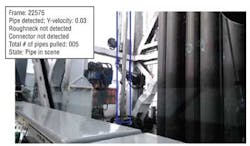p.2 ~ Real-time data images enhance rig safety, efficiency
View Article as Single page
Passenger manifest generation
During an emergency evacuation situation, knowledge of personnel locations is required for efficient evacuation and deployment of rescue vehicles. Knowing who has boarded a lifeboat or raft versus who may still be on board the rig can save lives. It makes sense to leverage camera technologies to track and identify people as they enter muster areas (or lifeboats or rafts), and automatically generate passenger manifest/muster lists. In the case of an emergency, these manifests can be immediately and automatically sent ashore, with a listing of personnel, a photo of them boarding the lifeboat or raft and their company ID photo for comparison, for further analysis.
The technology also can be used to identify people as they enter an enclosed space. As each person enters the scene, face detection algorithms are applied to isolate the subject's face, and then machine learning and pattern recognition techniques are used to match the face to a pre-existing database of faces (e.g., from ID photos, or photographs taken when people arrive on the rig). This information can then be used to generate a passenger manifest.
Whole rig analysis
At a bigger picture level, many on-board sensing problems are complicated by the nature of the dozens of interacting activities that go on during drilling. For example, pit-volume sensors are relatively mature and robust, and unexpected changes in pit-volume are a good indication of unexpected influx. However, automated influx alarms based solely on data from a pit-volume sensor typically have low detection probabilities and high false alarm rates, causing these automated alerts to be ignored or turned off. The cause is often the lack of big-picture awareness in any one sensing application. In the pit volume example, many different rig activities can affect the pit-volume, which significantly complicates timely influx detection. Understanding the interaction of the different factors that can affect multiple sensors is, therefore, fundamental to robust automated processing.
In addition to solving small-scale sensing problems, computer vision technologies can be used to help solve large-scale rig problems. In the general case, computer vision can identify behaviors and situations that have an effect on any sensing application, and that additional information can be used to improve automated data interpretation and alarm generation.
Conclusions
Collecting and automatically analyzing data is an important part of modern safe and efficient drilling. Computer vision technologies currently under development at CoVar Applied Technologies can analyze video feeds to enable low-cost, effective measurement of a number of personnel-based operational and safety factors that are difficult or expensive to analyze with classical instrumentation.
However, the potential applicability of computer vision on the rig is much larger than these specific technology applications. In the future, computer vision could be leveraged to provide a whole-rig analysis of operations and activities which can significantly simplify processing data from currently existing data sources.
The authors
Dr. Peter Torrione is a co-founder and CTO of CoVar Applied Technologies. His expertise is in the application of machine learning and computer vision techniques to solve real-world problems. Prior to joining CoVar, Torrione was the President of New Folder Consulting, L.L.C., and an Assistant Research Professor at Duke University, where he received his PhD in Electrical and Computer Engineering.
Dr. Kenneth D. Morton, Jr., is a co-founder and Chief Scientist of CoVar Applied Technologies. His research is focused on the use of Bayesian statistical methods to improve performance for signal processing and machine learning problems in a variety of real-time and real-world application areas. Morton received the BS degree in electrical and computer engineering from the University of Pittsburgh and MS and PhD degrees in electrical and computer engineering from Duke University.
Mark Hibbard is President and CEO of CoVar Applied Technologies, Inc. Prior to founding CoVar, Mark was Executive Vice President and Chief Technology Officer of NIITEK, Inc., a company dedicated to saving warfighter lives through the development and manufacture of its proprietary ground penetrating radar sensor systems. Hibbard has a Bachelor of Science in Physics from the College of William and Mary and a Master of Business Administration from the Robert H. Smith School of Business, University of Maryland.
Privacy concerns
There has historically been significant push-back from drilling rig crews against the application of certain video technologies on rigs. Crew concerns are typically related to the sense that video technologies represent an imposing "big brother" monitoring system. In fact, to the degree video monitoring is used to micro-manage and critique, it can be an unwelcome intrusion into an already stressful and difficult environment.
Most of the application areas discussed here (e.g., shale shaker, pipe handling) are relatively distinct from classic big-brother-type monitoring, and people should rarely be visible in these video streams. However, other technologies (e.g., PVM, muster-point) can be easily misconstrued as an automated, ever-present behavior monitors. For these application areas, it is important to draw a firm and clear line between what is monitored (person locations in PVM, and times and identities of people entering evacuation systems in muster-point analysis), and what is not monitored (person identities and activities, lengths of breaks, etc.).
The goal of this ongoing video technology development is to increase safety of personnel on the rig, whether by preventing man-machine collisions or by ensuring that everyone has evacuated during an emergency situation successfully. Proper communication of the goals (and built-in limitations) of these technologies is therefore required to get crew buy-in and to build the next generation of safer rig systems.

